Common pheasant
The common pheasant (Phasianus colchicus) is a bird in the pheasant family (Phasianidae). The genus name comes from Latin phasianus, "pheasant". The species name colchicus is Latin for "of Colchis" (modern day Georgia), a country on the Black Sea where pheasants became known to Europeans.[2] It diverged from the genus Gallus where domestic chicken belong about 20 million years ago.[3]
| Common pheasant | |
|---|---|
.jpg) | |
| Male ("cock") of hybrid stock in Poland Note thin white neck-band due to a ring-necked subspecies' contribution to hybrid gene pool | |
 | |
| Female ("hen") in England | |
| Scientific classification | |
| Kingdom: | Animalia |
| Phylum: | Chordata |
| Class: | Aves |
| Order: | Galliformes |
| Family: | Phasianidae |
| Genus: | Phasianus |
| Species: | P. colchicus |
| Binomial name | |
| Phasianus colchicus | |
 | |
It is native to Asia and parts of Europe like the northern foothills of Caucasus and the Balkans. It has been widely introduced elsewhere as a game bird. In parts of its range, namely in places where none of its relatives occur such as in Europe, where it is naturalised, it is simply known as the "pheasant". Ring-necked pheasant is both the name used for the species as a whole in North America and also the collective name for a number of subspecies and their intergrades that have white neck rings.
It is a well-known gamebird, among those of more than regional importance perhaps the most widespread and ancient one in the whole world. The common pheasant is one of the world's most hunted birds;[4] it has been introduced for that purpose to many regions, and is also common on game farms where it is commercially bred. Ring-necked pheasants in particular are commonly bred and were introduced to many parts of the world; the game farm stock, though no distinct breeds have been developed yet, can be considered semi-domesticated. The ring-necked pheasant is the state bird of South Dakota, one of only three U.S. state birds that is not a species native to the United States.
The green pheasant (P. versicolor) of Japan is sometimes considered a subspecies of the common pheasant. Though the species produce fertile hybrids wherever they coexist, this is simply a typical feature among fowl (Galloanseres), in which postzygotic isolating mechanisms are slight compared to most other birds. The species apparently have somewhat different ecological requirements and at least in its typical habitat, the green pheasant outcompetes the common pheasant. The introduction of the latter to Japan has therefore largely failed.
Description
.jpg)
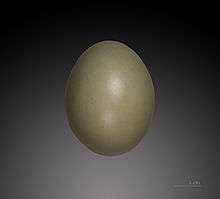
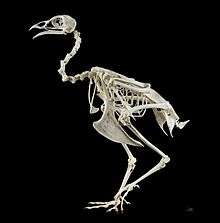
There are many colour forms of the male common pheasant, ranging in colour from nearly white to almost black in some melanistic examples. These are due to captive breeding and hybridization between subspecies and with the green pheasant, reinforced by continual releases of stock from varying sources to the wild. For example, the "ring-necked pheasants" common in Europe, North America and Australia do not pertain to any specific taxon, they rather represent a stereotyped hybrid swarm.[5] Body weight can range from 0.5 to 3 kg (1.1 to 6.6 lb), with males averaging 1.2 kg (2.6 lb) and females averaging 0.9 kg (2.0 lb).[6]
The adult male common pheasant of the nominate subspecies Phasianus colchicus colchicus is 60–89 cm (24–35 in) in length with a long brown streaked black tail, accounting for almost 50 cm (20 in) of the total length. The body plumage is barred bright gold or fiery copper-red and chestnut-brown plumage with iridescent sheen of green and purple; but rump uniform is sometimes blue. The wing coverage is white or cream and black-barred markings are common on the tail.[7] The head is bottle green with a small crest and distinctive red wattle. P. c. colchicus and some other races lack a white neck ring.[8] Behind the face are two ear-tufts, that make the pheasant more alert.[9]
The female (hen) and juveniles are much less showy, with a duller mottled brown plumage all over and measuring 50–63 cm (20–25 in) long including a tail of around 20 cm (7.9 in). Juvenile birds have the appearance of the female with a shorter tail until young males begin to grow characteristic bright feathers on the breast, head and back at about 10 weeks after hatching.[7]
The green pheasant (P. versicolor) is very similar, and hybridization often makes the identity of individual birds difficult to determine. Green pheasant males on average have a shorter tail than the common pheasant and have darker plumage that is uniformly bottle-green on the breast and belly; they always lack a neck ring. Green pheasant females are darker, with many black dots on the breast and belly.
In addition, various color mutations are commonly encountered, mainly melanistic (black) and flavistic (isabelline or fawn) specimens. The former are rather common in some areas and are named Tenebrosus pheasant (P. colchicus var. tenebrosus).
Taxonomy and systematics
This species was first scientifically described by Linnaeus in his Systema naturae in 1758 under its current scientific name. The common pheasant is distinct enough from any other species known to Linnaeus for a laconic [Phasianus] rufus, capîte caeruleo – "a red pheasant with blue head" – to serve as entirely sufficient description. Moreover, the bird had been extensively discussed before Linnaeus established binomial nomenclature. His sources are the Ornithologia of Ulisse Aldrovandi,[10] Giovanni Pietro Olina's Uccelliera,[11] John Ray's Synopsis methodica Avium & Piscium,[12] and A natural history of the birds by Eleazar Albin.[13] Therein—essentially the bulk of the ornithology textbooks of his day—the species is simply named "the pheasant" in the books' respective languages. Whereas in other species, such as the eastern meadowlark (Sturnella magna), Linnaeus felt it warranted to cite plumage details from his sources, in the common pheasant's case he simply referred to the reason of the bird's fame: principum mensis dicatur. The type locality is given simply as "Africa, Asia".[14]
However, the bird does not occur in Africa, except perhaps in Linnaeus' time in Mediterranean coastal areas where they might have been introduced during the Roman Empire. The type locality was later fixed to the Rioni River in Western Georgia – known as Phasis to the Ancient Greeks. These birds, until the modern era, constituted the bulk of the introduced stock in parts of Europe that wasn't already present; the birds described by Linnaeus' sources, though typically belonging to such early introductions, would certainly have more alleles in common with the transcaucasian population than with others. The scientific name is Latin for "pheasant from Colchis", colchicus referring to the west of modern-day Georgia;[15] the Ancient Greek term corresponding to the English "pheasant" is Phasianos ornis (Φασιανὸς ὂρνις), "bird of the river Phasis".[16] Although Linnaeus included many Galliformes in his genus Phasianius—such as the domestic chicken and its wild ancestor the red junglefowl, nowadays Gallus gallus—today only the common and the green pheasant are placed in this genus. As the latter was not known to Linnaeus in 1758, the common pheasant is naturally the type species of Phasianus.
In the US, common pheasants are widely known as "ring-necked pheasants". More colloquial North American names include "chinks" or, in Montana, "phezzens".[17] In China, meanwhile, the species is properly called zhi ji (雉鸡)—"pheasant-fowl"—essentially implying the same as the English name "common pheasant". Like elsewhere, P. colchicus is such a familiar bird in China that it is usually just referred to as shan ji (山雞), "mountain chicken",[18] a Chinese term for pheasants in general.
As of 2005, it had the smallest known genome of all living amniotes, only 0.97 pg (970 million base pairs), roughly one-third of the human genome's size; however, the black-chinned hummingbird is now currently held to have the smallest.[19]
Subspecies
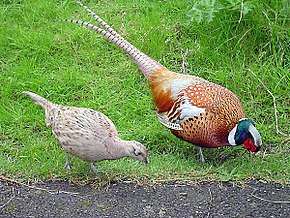
There are about 30 subspecies in five[20] up to eight[21] groups. These can be identified according to the male plumage, namely presence or absence of a white neck-ring and/or a white superciliary stripe, the color of the uppertail (rump) and wing coverts, and the color of crown, chest, upper back, and flank feathers. As noted above, introduced population in our time mix the alleles of various races in various amounts, differing according to the original stock used for introductions and what natural selection according to climate and habitat has made of that.
An investigation into the genetic relationships of subspecies revealed that the earliest subspecies is likely to have been elegans, suggesting that the Common Pheasant originated from the forests of southeastern China. Initial divergence is thought to have occurred around 3.4 Mya. The lack of agreement between morphology-based subspecies delimitation and their genetic relationships is thought to be attributed to past isolation followed by more recent population mixing as the pheasant has expanded its range across the western Palaearctic.[22]
Sometimes this species is split into the Central Asian common and the East Asian ring-necked pheasants, roughly separated by the arid and high mountainous regions of Turkestan. However, while the western and eastern populations probably were entirely separate during the Zyryanka glaciation when deserts were more extensive,[23] this separation was not long enough for actual speciation to occur. Today, the largest variety of color patterns is found where the western and eastern populations mix, as is to be expected. Females usually cannot be identified even to subspecies group with certainty.
Many subspecies are in danger to disappear due to hybridization with introduced birds. The last indigenous black-necked pheasant (P. c. colchicus) population in Europe survives in Greece in the delta of the river Nestos, where in 2012 the population was estimated 100-250 individuals.[22]
The subspecies groups, going from west to east, and some notable subspecies are:[21]
| Subspecies | Range | Description | Image |
|---|---|---|---|
| WESTERN CLADE - Red-rumped pheasants: | The lower back, rump, and upper tail-coverts are of a bronze-red, maroon, or rusty-orange general colour, sometimes glossed with oily green; black bars on the tail generally narrow. | ||
| Colchicus group - Black-necked pheasants: colchicus, septentrionalis, talischensis, persicus | Caucasus to W Turkestan, Turkey (Samsun area)[24] and Greece (Nestos delta)[22] | No neck ring. Wing coverts buff to brown (in persicus greyish white or buffy white), uppertail coverts rusty to chestnut | .jpg) |
| Chrysomelas/principalis group - White-winged pheasants: principalis, zarudnyi, zerafschanicus, bianchii, chrysomelas, shawii | Central Turkestan and western Tarim Basin | No or vestigial neck ring. Wing coverts white, uppertail coverts and general plumage hue bronze to brown | |
| Mongolicus group - Kyrghyz pheasants: turcestanicus, mongolicus | NE Turkestan and adjacent Xinjiang. Note that, despite its name, mongolicus does not occur in Mongolia. | Broad neck ring. Wing coverts white, uppertail coverts hue rusty to chestnut, general plumage hue copper | .jpg) |
| Tarimensis group - Tarim pheasants: tarimensis | SE Turkestan around the eastern Tarim Basin | No or vestigial neck ring. Wing coverts buff to brown, uppertail coverts dark khaki to light olive |  |
| EASTERN CLADE - Grey-rumped pheasants: | The lower back, rump, and upper tail-coverts are of a light and more or less lavender-blue, greenish- or yellowish-grey, or olive-greenish color; a rusty orange patch on each side of the rump; black tail-bars generally broad. | ||
| Elegans group - Yunnan pheasants: elegans, rothschildi | Eastern Tibet, Western Sichuan, Northwestern and Southeastern Yunnan, Northwestern Vietnam and Northern Myanmar. | White neck collar and orbital lines are absent. A broad band of richly glossed dark green or bluish green colour runs down the underparts, completely separating the brassy-chestnut of the sides of the chest. Crown dark green. Uppertail coverts light bluish grey. | |
| Strauchi/vlangalii group - Western grey-rumped pheasants: hagenbecki, vlangalii, satscheuensis, edzinensis, strauchi, sohokhotensis, alaschanicus, suehschanensis, kiangsuensis | Qaidam Basin, Eastern Qinghai, Northeastern Sichuan, Inner Mongolia, Gansu, Ningxia, Shanxi, Shaanxi, Western Hebei. Note that, despite its name, kiangsuensis does not occur in Jiangsu. | With the exception of hagenbecki, the white neck collar and orbital lines are usually either absent (suehschanensis) or rather narrow, often not complete. Brassy-chestnut on chest dominating over glossy green colour (which only in suehschanensis reaches from foreneck to the belly). In hagenbecki chest feathers broadly fringed black. Crown usually dark green (grey in hagenbecki). | |
| Torquatus group - Chinese ring-necked pheasants: pallasi, karpowi, torquatus, takatsukasae, decollatus | Widespread in Eastern China, extending to northernmost Vietnam in the south and to the Strait of Tartary region in the north. Absent from Hainan. Most pheasants in North America are of this group. | White neck ring varies from broad in the North East (pallasi) to absent in the South West (decollatus). Wing coverts tan to light grey (almost white in some). Chest copper red to light brown red, in decollatus rich purple red with thick black feather margins. Crown varying from dark green without orbital lines (decollatus) to light grey framed with white orbital lines. | |
| Formosanus group - Taiwan pheasants: formosanus | Taiwan | White neck ring interrupted at front neck. Flank feathers characteristically whitish or pure white with black apices and often narrow black margins. Feathers at chest broadly fringed black, giving a scaly appearance. |  |
| Examples: | |||
| P. c. pallasi (Manchurian ring-necked pheasant) | Southeastern Siberia (Ussuriland, Southern Amurland), adjacent Northeastern North Korea (alpine region) to northeastern China (East and South slopes of Greater Khingan Mountains and Lesser Khingan Mountains) | Coloration of plumage dominated by yellow and copper brown tones. Greyish green crown, framed by white orbital lines. White collar very wide and uninterrupted, often broader at the front. | .jpg) |
| P. c. karpowi (Korean ring-necked pheasant) | Northeastern China (Southern Heilongjiang, Jilin, Northern Liaoning, Northern Hebei) and central and southern Korean Peninsula and Jeju Island in S.Korea. Introduced on Hokkaido, Japan.[25] | Darker and more richly coloured than P. c. pallasi, and white collar narrower. |  |
Within a maximum clade credibility mDNA gene tree, the most basal group is the Elegans-group of the Eastern Clade, diverging from the Green pheasant during the Calabrian, and diversifying in Middle Pleistocene around 0.7 Million years ago, with the groups of the Western Clade splitting off from those of the Eastern Clade about 0.59 Million years ago.[21] While the subspecies of the Western Clade are well geographically separated from each other, the subspecies of the Eastern clade often show clinal variation and large areas of intergradation. For example, clines connect pallasi-karpowi-torquatus-takatsukasae within the Torquatus-group and kiangsuensis-alaschanicus-sohokhotensis-strauchi within the Strauchi/vlangalii-group, with the degree of expression of white collar and superciliary stripe in both cases decreasing from North to South.
Ecology
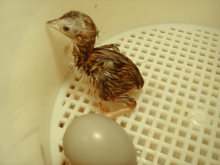
Common pheasants are native to Asia and parts of Europe, their original range extending from the Balkans (where the last truly wild birds survive around Nestos river in Greece), the Black and Caspian Seas to Manchuria, Siberia, Korea, Mainland China, and Taiwan. The birds are found in woodland, farmland, scrub, and wetlands. In its natural habitat the common pheasant lives in grassland near water with small copses of trees.[20] Extensively cleared farmland is marginal habitat that cannot maintain self-sustaining populations for long[26][27]
Common pheasants are gregarious birds and outside the breeding season form loose flocks. However, captive bred Common Pheasants can show strong sexual segregation, in space and time, with sex differences in the use of feeding stations throughout the day.[28] Wherever they are hunted they are always timid once they associate humans with danger, and will quickly retreat for safety after hearing the arrival of hunting parties in the area.

While common pheasants are able short-distance fliers, they prefer to run. If startled however, they can suddenly burst upwards at great speed, with a distinctive "whirring" wing sound and often giving kok kok kok calls to alert conspecifics. Their flight speed is only 43–61 km/h (27–38 mph) when cruising but when chased they can fly up to 90 km/h (56 mph).
Nesting
Common pheasants nest solely on the ground in scrapes, lined with some grass and leaves, frequently under dense cover or a hedge. Occasionally they will nest in a haystack, or old nest left by other birds they roost in sheltered trees at night. The males are polygynous as is typical for many Phasianidae, and are often accompanied by a harem of several females.[29] Common pheasants produce a clutch of around 8–15 eggs, sometimes as many as 18, but usually 10 to 12; they are pale olive in colour, and laid over a 2–3 week period in April to June. The incubation period is about 22–27 days. The chicks stay near the hen for several weeks, yet leave the nest when only a few hours old. After hatching they grow quickly, flying after 12–14 days, resembling adults by only 15 weeks of age.
They eat a wide variety of animal and vegetable type-food, like fruit, seeds, grain, mast, berries and leaves as well as a wide range of invertebrates, such as leatherjackets, ant eggs, wireworms, caterpillars, grasshoppers and other insects; with small vertebrates like lizards, field voles, small mammals, and small birds occasionally taken.[8]
European native
Southern Caucasian Pheasants P.c.colchicus were common in Greece during the classical period and it is a widespread myth that the Greeks brought pheasants to the Balkans when they colonized Colchis in the Caucasus. This colonization happened during the 6th century BC, but pheasant archaeological remains in the Balkans are much older dating to 6th millennium BC. This fact indicates that probably pheasants reached the area naturally.[30][31] Additionally it seems that they had a continuous range in Turkey from the Sea of Marmara on the edge of the Balkans, across the northern shore of the country till Caucasus.[32] The last remnants of the Balkan population survive in the Kotza-Orman riparian forest of Nestos, in Greece with an estimated population of 100-200 adult birds.[33] In Bulgaria they were lost in the 1970s because they hybridized with introduced eastern subspecies.[34]
Besides the Balkans the species lives in Europe in the area north of Caucasus where the local subspecies P.c.septentrionalis survives pure around the lower reaches of the Samur River. Reintroduction efforts in the rest of the north Caucasian range may include hybrid birds.[35]
As an introduced species

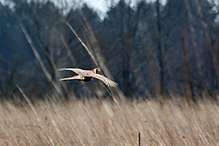
Common pheasants can now be found across the globe due to their readiness to breed in captivity and the fact they can naturalise in many climates, but were known to be introduced in Europe, North America, Japan and New Zealand. Pheasants were hunted in their natural range by Stone Age humans just like the grouse, partridges, junglefowls and perhaps peafowls that inhabited Europe at that time. At least since the Roman Empire, the bird was extensively introduced in many places and has become a naturalized member at least of the European fauna. Introductions in the Southern Hemisphere have mostly failed, except where local Galliformes or their ecological equivalents are rare or absent.
The bird was naturalized in Great Britain around A.D. 1059, but may have been introduced by the Romano-British centuries earlier.[36] It was the Caucasian subspecies mistakenly known as the 'Old English Pheasant' rather than the Chinese ring-necked pheasants (torquatus) that were introduced to Britain.[37] But it became extirpated from most of the isles in the early 17th century. There were further re-introductions of the 'white neck-ringed' variety in the 18th century. It was rediscovered as a game bird in the 1830s after being ignored for many years in an amalgam of forms. Since then it has been reared extensively by gamekeepers and was shot in season from 1 October to 31 January. Pheasants are well adapted to the British climate and breed naturally in the wild without human supervision in copses, heaths and commons.
By 1950 pheasants bred throughout the British Isles, although they were scarce in Ireland. Because around 30,000,000 pheasants are released each year on shooting estates, mainly in the Midlands and South of England, it is widespread in distribution, although most released birds survive less than a year in the wild. The Bohemian was most likely seen in North Norfolk.[38] The Game & Wildlife Conservation Trust is researching the breeding success of reared pheasants and trying to find ways to improve this breeding success to reduce the demand to release as many reared pheasants and increase the wild population. As the original Caucasian stock all but disappeared during the Early Modern era, most 'dark-winged ringless' birds in the U.K. are actually descended from 'Chinese ring-necked' and 'green pheasant' hybrids,[39] which were commonly used for rewilding.
North America
Common pheasants were introduced in North America in 1773,[40] and have become well established throughout much of the Rocky Mountain states (Colorado, Montana, Wyoming, etc.), the Midwest, the Plains states, as well as Canada and Mexico.[41][42] In the southwest, they can even be seen south of the Rockies in Bosque del Apache National Wildlife Refuge 161 km (100 mi) south of Albuquerque, New Mexico. It is now most common on the Great Plains. Common pheasants have also been introduced to much of northwest Europe, the Hawaiian Islands, Chile, Uruguay, Peru, Argentina, Brazil, South Africa, New Zealand, and Australia including the island state of Tasmania and small offshore islands such as Rottnest Island off Western Australia.[43][44]
Most common pheasants bagged in the United States are wild-born feral pheasants. In some states[45] captive-reared and released birds make up much of the population.[46]
Pheasant hunting is very popular in much of the U.S., especially in the Great Plains states, where a mix of farmland and native grasslands provides ideal habitat. South Dakota alone has an annual harvest of over a million birds a year by over 200,000 hunters.[47]
As gamebirds
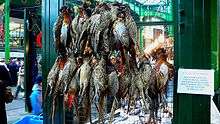

Common pheasants are bred to be hunted and are shot in great numbers in Europe, especially the U.K., where they are shot on the traditional formal "driven shoot" principles, whereby paying guns have birds driven over them by beaters, and on smaller "rough shoots". The open season in the U.K. is 1 October – 1 February, under the Game Act 1831. Generally they are shot by hunters employing gun dogs to help find, flush and retrieve shot birds. Retrievers, spaniels and pointing breeds are used to hunt pheasants.
The doggerel "Up gets a guinea, bang goes a penny-halfpenny, and down comes a half a crown" reflects the expensive sport of 19th century driven shoots in Britain,[49] when pheasants were often shot for sport, rather than as food. It was a popular royal pastime in Britain to shoot common pheasants. King George V shot over 1,000 pheasants out of a total bag of 3,937 over a six-day period in December 1913 during a competition with a friend; however, he did not do enough to beat him.[39]
Common pheasants are traditionally a target of small game poachers in the U.K. but, due to the low value of pheasants in the modern day, some have resorted to stealing chicks or poults from pens.[50] The Roald Dahl novel Danny the Champion of the World dealt with a poacher (and his son) who lived in the United Kingdom and illegally hunted common pheasants.
Pheasant farming is a common practice and is sometimes done intensively. Birds are supplied both to hunting preserves/estates and restaurants, with smaller numbers being available for home cooks.
The carcasses were often hung for a time to improve the meat by slight decomposition, as with most other game. Modern cookery generally uses moist roasting and farm-raised female birds. In the U.K. and U.S., game is making somewhat of a comeback in popular cooking and more pheasants than ever are being sold in supermarkets there.[51] A major reason for this is consumer attitude shift from consumption of red meat to white meat.[51]
See also
- Hunting and shooting in the United Kingdom
References
- BirdLife International (2012). "Phasianus colchicus". IUCN Red List of Threatened Species. 2012. Retrieved 26 November 2013.CS1 maint: ref=harv (link)
- Jobling, James A (2010). The Helm Dictionary of Scientific Bird Names. London: Christopher Helm. pp. 113, 302. ISBN 978-1-4081-2501-4.
- Lawal, RA.; et al. (2020). "The wild species genome ancestry of domestic chickens". BMC Biology. 18 (13): 13. doi:10.1186/s12915-020-0738-1. PMID 32050971.
- Robertson 1997, pp. 123–136
- Sibley 2000, p. 141
- "Ring-necked Pheasant". All About Birds. Cornell Lab of Ornithology. Retrieved 25 April 2011.
- Scott, p.85
- British Book of Birds, p.69
- The Observer's Book of Birds, p.214
- Aldrovandi 1600, pp. 45–59
- Olina 1622, p. 49, plate 48
- Ray 1713, p. 56
- Albin 1731, pp. 24–26
- Linnaeus 1758
- URB 2007
- "pheasant". Oxford English Dictionary (3rd ed.). Oxford University Press. September 2005. (Subscription or UK public library membership required.)
- Proper 1990, pp. 21–22
- e.g. Lin-Liu et al. 2006
- Gregory, T.R. (2005). "Birds – Animal Genome Size Database". Genomesize.com. Archived from the original on 14 May 2011. Retrieved 25 April 2011.
- Madge, McGowan & Kirwan 2002
- Liu, S.; Liu, Y.; Jelen, E.; Alibadian, M.; Yao, Ch.-T.; Li, X.; Kayvanfar, N.; Wang,; Vahidi, F.; Han, J.; Sundev, G.; Zhang, Zh.; Schweizer, M. (21 December 2019). "Regionally divergent drivers of historical diversification in the late Quaternary in a widely distributed generalist species, the common pheasant Phasianus colchicus". bioRxiv. doi:10.1101/2019.12.21.881813. Retrieved 4 March 2020.CS1 maint: extra punctuation (link)
- Sokos, Ch.; Birtsas, P. (2014). "The last indigenous Black-necked Pheasant population of Europe" (PDF). G@llinformed. 8: 13–22.
- Ray & Adams 2001
- Kumerloeve, H. (1976). "Zum Vorkommen und zur taxonomischen Beurteilung türkischer Populationen von Phasianus colchicus L." (PDF). Bonn. Zool. Beitr. 27 (1/2): 47–52.
- Bohl, W. H. (1964). "A Study and Review of the Japanese Green and the Korean Ring-necked Pheasants". Special Sicentific Report - Wildlife, United States Department of the Interior, Fish and Wildlife Service, Bureau of Sport Fisheries and Wildlife. 83: 1–65.
- Henninger 1906
- OOS 2004
- Whiteside, M.A.; van Horik, J. O.; Langley, E.J.G.; Beardsworth, C.E.; Capstick, L.A.; Madden, J.R. (2019). "Patterns of association at feeder stations for Common Pheasants released into the wild: sexual segregation by space and time". Ibis. 161 (2): 325–336. doi:10.1111/ibi.12632. hdl:10871/33788.
- NDGFD 1992
- Fet, V. & A. Popov 2007: Biogeography and Ecology of Bulgaria. Springer.
- Sokos, C. & P. Birtsas 2014: The last indigenous black-necked pheasant population of Europe. G@lliformed 8: 13-22.
- Gürler, A.T., Bölükbaş, C.S., Pekmezci, G.Z., Umur, S. & M. Açıcı1 2012: Samsun’da Sülünlerde (Phasianus colchicus) Nekropsi ve Dışkı Bakısında Saptanan Helmintler. Turkiye Parazitol Derg 36: 222-227.
- Χανδρινός, Γ. 2009: Φασιανός. Το Κόκκινο Βιβλίο των Απειλούμενων Ζώων της Ελλάδας: 243.
- Braasch, T., Pes, T., Michel, S. & H. Jacken 2011: The subspecies of the common pheasant Phasianus colchicus in the wild and captivity. International Journal of Galliformes Conservation 2: 6-13.
- Kayvanfar, N., Aliabadian, M., Niu, X., Zhang, Z. & Y.Liu 2017: Phylogeography of the Common Pheasant Phasianus colchicus. Ibis 159: 430-442.
- Cross 2006
- Book of British Birds, p.69
- Scott, p.86
- h2g2 2007
- Farm, MacFarlane Pheasants - Pheasant Chicks, Mature Birds, America's Largest Pheasant. "Pheasant History and Facts". www.pheasant.com. Retrieved 10 March 2017.
- Terry, John (20 August 2011). "Oregon pioneer Owen Nickerson Denny was about more than his birds". OregonLive.com. Retrieved 11 March 2012.
- "Pheasant History, Ecology & Biology". Pheasantsforever.org. Archived from the original on 1 March 2012. Retrieved 11 March 2012.
- Long, John L. (1981). Introduced Birds of the World. Agricultural Protection Board of Western Australia. pp. 21–493.
- "Phasianus colchicus Linnaeus, 1758". National Research Infrastructure for Australia.
- e.g. Ohio: OOS 2004
- Robertson 1997, p. 125
- "Pheasant" (PDF). gfp.sd.gov. South Dakota Game, Fish and Parks. Retrieved 10 March 2013.
- "Roadkill: One from the road". The Independent. London. 7 September 2006. Archived from the original on 9 April 2010. Retrieved 25 April 2011.
- Robertson 1997, p. 124
- BBC Four 2005
- "Game To Eat". Game To Eat. Archived from the original on 29 May 2012. Retrieved 25 April 2011.
Bibliography
- Albin, Eleazar (1731). A natural history of the birds. London: William Innys.CS1 maint: ref=harv (link)
- Aldrovandi, Ulisse (Ulyssis Aldrovandus) (1600). Ornithologia. vol. 2: Tomus alter. Archived from the original on 18 December 2012.CS1 maint: ref=harv (link)
- BBC Four (11 June 2005). "Open Country". Retrieved 21 February 2008.
- Cross, Nigel (2006). "Some foods introduced by the Romans to Britain". Retrieved 21 February 2008.CS1 maint: ref=harv (link)
- hg (17 August 2007). "Common Pheasant and Relatives". Retrieved 21 February 2008.
- Henninger, W.F. (1906). "A preliminary list of the birds of Seneca County, Ohio" (PDF). Wilson Bulletin. 18 (2): 47–60.CS1 maint: ref=harv (link)
- Lin-Liu, Jen; McMahon, Dinny; Mooney, Paul; Owyang, Sharon; Reiber, Beth; Smith, Graeme; Winnan, Christopher D. (2006). Frommer's China (2nd ed.). John Wiley & Sons. ISBN 978-0-7645-9743-5.CS1 maint: ref=harv (link)
- Linnaeus, Carl (1758). 90.3. Phasianus colchicus. Systema naturae per regna tria naturae, secundum classes, ordines, genera, species, cum characteribus, differentiis, synonymis, locis. vol. 1 (10th ed.). Holmius (Stockholm): Laurentius Salvius. p. 158.CS1 maint: ref=harv (link)
- Madge, Steve; McGowan, Philip J.K.; Kirwan, Guy M. (2002). Pheasants, partridges and grouse: a guide to the pheasants, partridges, quails, grouse, guineafowl, buttonquails and sandgrouse of the world. London: Christopher Helm. ISBN 978-0-7136-3966-7.CS1 maint: ref=harv (link)
- North Dakota Game and Fish Department (NDGFD) (1992). "The ring-necked pheasant in North Dakota". North Dakota Outdoors. 54 (7): 5–20. Archived from the original on 8 May 2009.
- Olina, Giovanni Pietro (1622). Uccelliera. Archived from the original on 6 January 2013.CS1 maint: ref=harv (link)
- Ohio Ornithological Society (OOS) (April 2004). "Annotated Ohio state checklist" (PDF). Archived from the original (PDF) on 18 July 2004.
- Proper, Datus C. (1990). Pheasants of the Mind: A Hunter's Search for a Mythic Bird. Prentice Hall Press. ISBN 978-0-13-662750-0.CS1 maint: ref=harv (link)
- Ray, John (Joannis Raii) (1713). Synopsis methodica avium & piscium: opus posthumum, etc. Volume 1. London: William Innys.CS1 maint: ref=harv (link)
- Ray, Nicolas; Adams, Jonathan M. (2001). "A GIS-based Vegetation Map of the World at the Last Glacial Maximum (25,000–15,000 BP)" (PDF). Internet Archaeology (11). doi:10.11141/ia.11.2.CS1 maint: ref=harv (link)
- Robertson, Peter (1997). Pheasants. Voyageur Press, Inc. ISBN 978-0-89658-361-0.CS1 maint: ref=harv (link)
- Sibley, David Allen (2000). The Sibley Guide to Birds. New York: Knopf. ISBN 978-0-679-45122-8.CS1 maint: ref=harv (link)
- uk.rec.birdwatching (URB) (10 November 2007). "Scientific bird names explained". Retrieved 21 February 2008.
External links
| Wikimedia Commons has media related to Phasianus colchicus. |
| Wikispecies has information related to Phasianus colchicus |
- Ring-necked Pheasant - Phasianus colchicus - USGS Patuxent Bird Identification InfoCenter
- Ring-necked Pheasant Species Account – Cornell Lab of Ornithology
- Ring-necked Pheasant at enature.com
- Royal Society for the Protection of Birds (RSPB) Pheasant page
- "Ring-necked pheasant media". Internet Bird Collection.
- Ring-necked pheasant photo gallery at VIREO (Drexel University)
- Interactive range map of Phasianus colchicus at IUCN Red List maps

.jpg)
